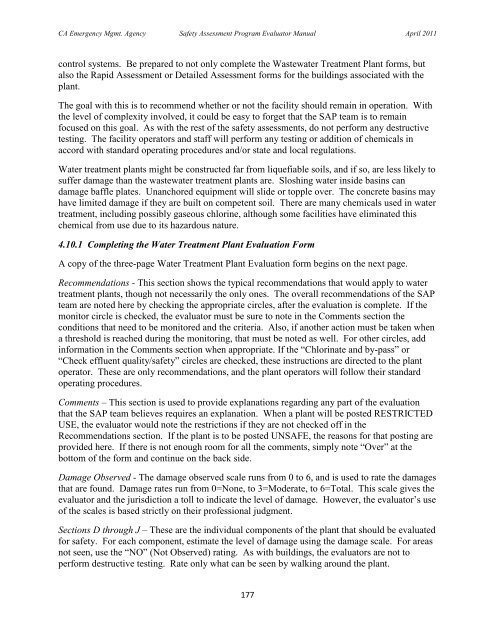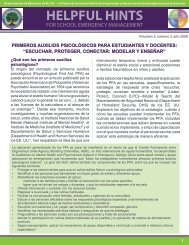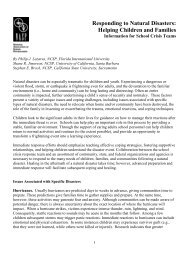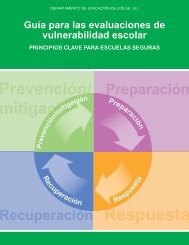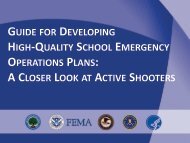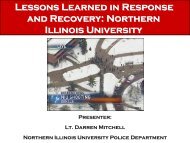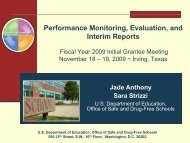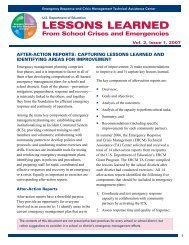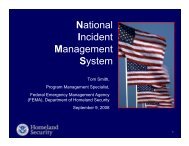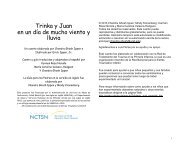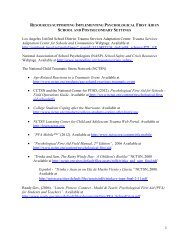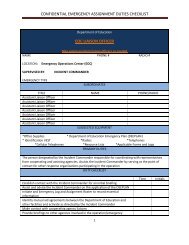Safety Assessment Program Evaluator Student Manual
Safety Assessment Program Evaluator Student Manual
Safety Assessment Program Evaluator Student Manual
You also want an ePaper? Increase the reach of your titles
YUMPU automatically turns print PDFs into web optimized ePapers that Google loves.
CA Emergency Mgmt. Agency <strong>Safety</strong> <strong>Assessment</strong> <strong>Program</strong> <strong>Evaluator</strong> <strong>Manual</strong> April 2011control systems. Be prepared to not only complete the Wastewater Treatment Plant forms, butalso the Rapid <strong>Assessment</strong> or Detailed <strong>Assessment</strong> forms for the buildings associated with theplant.The goal with this is to recommend whether or not the facility should remain in operation. Withthe level of complexity involved, it could be easy to forget that the SAP team is to remainfocused on this goal. As with the rest of the safety assessments, do not perform any destructivetesting. The facility operators and staff will perform any testing or addition of chemicals inaccord with standard operating procedures and/or state and local regulations.Water treatment plants might be constructed far from liquefiable soils, and if so, are less likely tosuffer damage than the wastewater treatment plants are. Sloshing water inside basins candamage baffle plates. Unanchored equipment will slide or topple over. The concrete basins mayhave limited damage if they are built on competent soil. There are many chemicals used in watertreatment, including possibly gaseous chlorine, although some facilities have eliminated thischemical from use due to its hazardous nature.4.10.1 Completing the Water Treatment Plant Evaluation FormA copy of the three-page Water Treatment Plant Evaluation form begins on the next page.Recommendations - This section shows the typical recommendations that would apply to watertreatment plants, though not necessarily the only ones. The overall recommendations of the SAPteam are noted here by checking the appropriate circles, after the evaluation is complete. If themonitor circle is checked, the evaluator must be sure to note in the Comments section theconditions that need to be monitored and the criteria. Also, if another action must be taken whena threshold is reached during the monitoring, that must be noted as well. For other circles, addinformation in the Comments section when appropriate. If the “Chlorinate and by-pass” or“Check effluent quality/safety” circles are checked, these instructions are directed to the plantoperator. These are only recommendations, and the plant operators will follow their standardoperating procedures.Comments – This section is used to provide explanations regarding any part of the evaluationthat the SAP team believes requires an explanation. When a plant will be posted RESTRICTEDUSE, the evaluator would note the restrictions if they are not checked off in theRecommendations section. If the plant is to be posted UNSAFE, the reasons for that posting areprovided here. If there is not enough room for all the comments, simply note “Over” at thebottom of the form and continue on the back side.Damage Observed - The damage observed scale runs from 0 to 6, and is used to rate the damagesthat are found. Damage rates run from 0=None, to 3=Moderate, to 6=Total. This scale gives theevaluator and the jurisdiction a toll to indicate the level of damage. However, the evaluator‟s useof the scales is based strictly on their professional judgment.Sections D through J – These are the individual components of the plant that should be evaluatedfor safety. For each component, estimate the level of damage using the damage scale. For areasnot seen, use the “NO” (Not Observed) rating. As with buildings, the evaluators are not toperform destructive testing. Rate only what can be seen by walking around the plant.177


